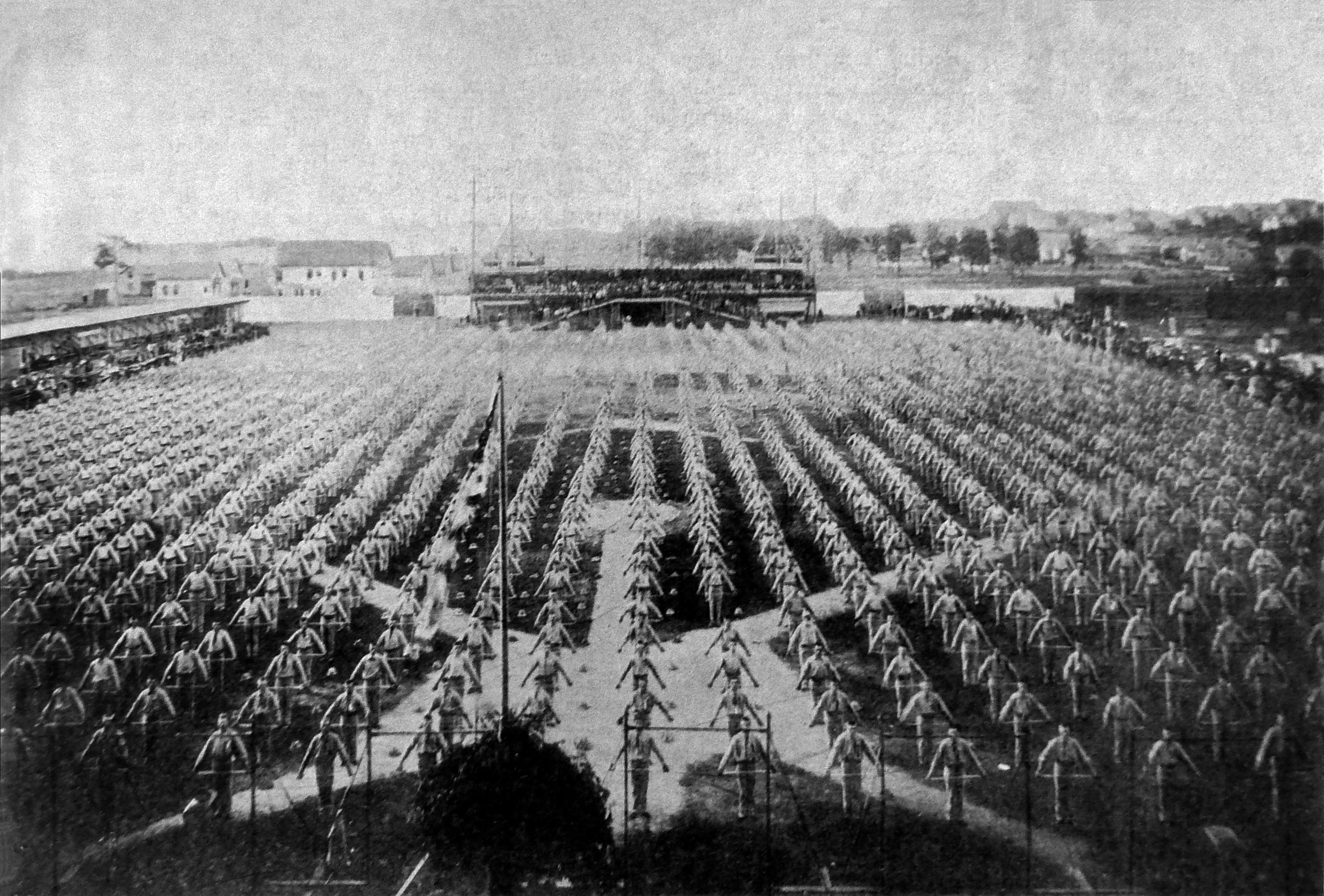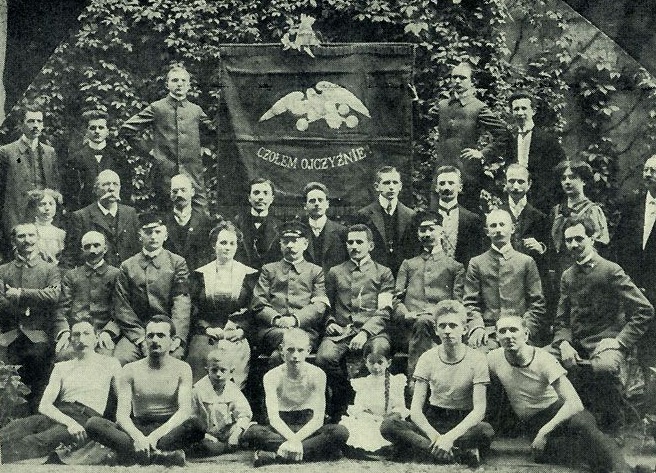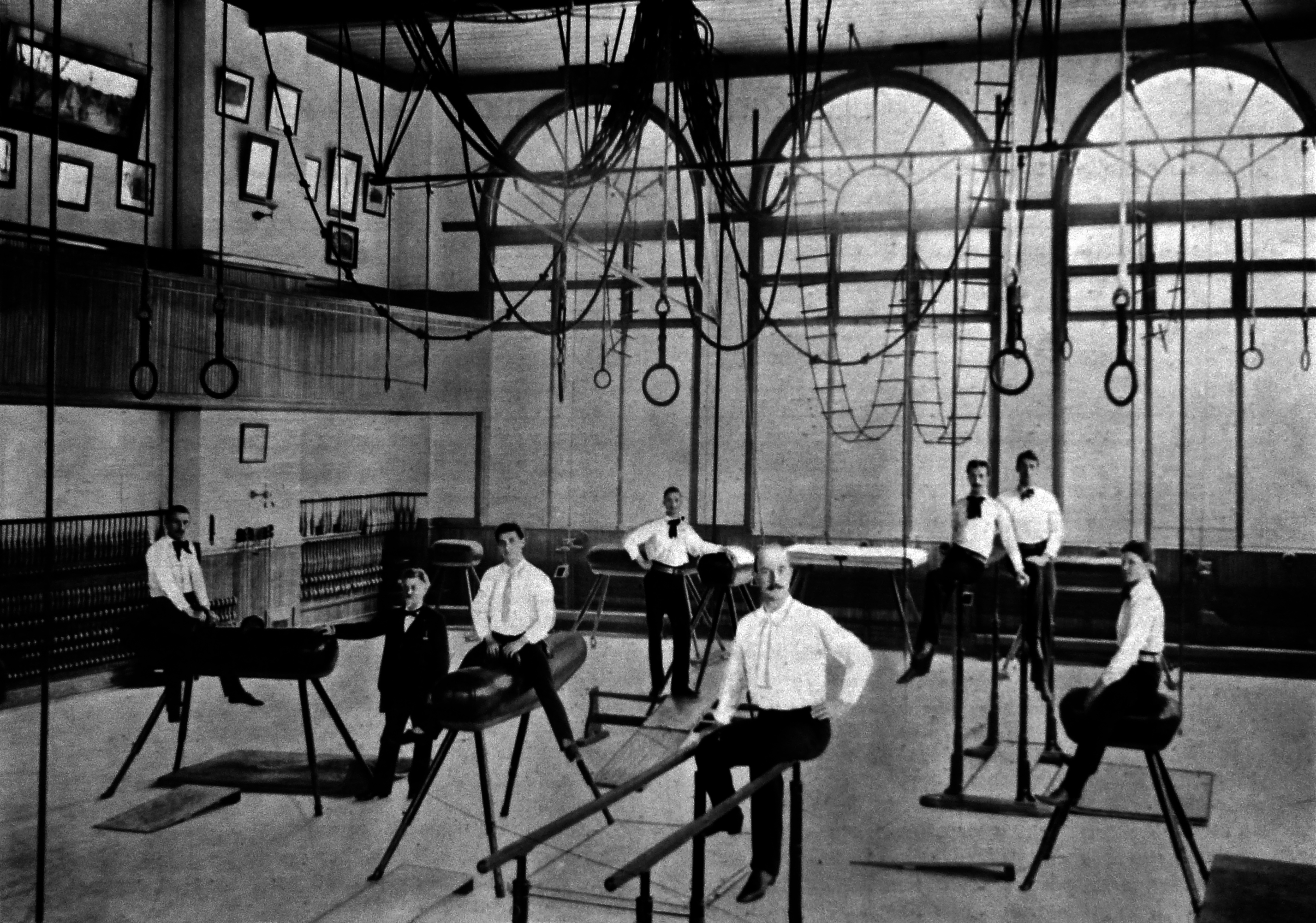|
Sokol
The Sokol movement (, ''falcon'') is an all-age gymnastics organization first founded in Prague in the Czech region of Austria-Hungary in 1862 by Miroslav Tyrš and Jindřich Fügner. It was based upon the principle of " a strong mind in a sound body". The Sokol, through lectures, discussions, and group outings provided what Tyrš viewed as physical, moral, and intellectual training for the nation. This training extended to men of all ages and classes, and eventually to women. The movement also spread across all the regions populated by Slavic cultures, most of them part of either Austria-Hungary or the Russian Empire: present-day Slovakia, the Slovene Lands, Croatia, Serbia ( SK Soko), Bulgaria, Poland ( Sokół), Ukraine, Belarus. In many of these nations, the organization also served as an early precursor to the Scouting movements. Though officially an institution "above politics", the Sokol played an important part in the development of Czech nationalism and patriotism ... [...More Info...] [...Related Items...] OR: [Wikipedia] [Google] [Baidu] |
Jindřich Fügner
Jindřich Fügner (born Heinrich Fügner, 12 September 1822, Prague – 15 November 1865, Prague) was co-founder (together with Miroslav Tyrš) and the first ''starosta'' (leader) of the Czech sport organization Sokol. Biography He was born in Prague (baptized in the church. Stephen) to Peter (1787-1863) and Frances (Františka) (1794-1863) Fügner. His father was a businessman (Handelsmann), a native of Leitmeritz. Police records show that the family of Peter and Frances had two daughters: Caroline and Julia and three sons: Ferdinand, Heinrich and Wilhelm. Thanks to private study and study abroad he gained a broad education and learned several foreign languages. Later, he run a trade insurance business. Though his business was successful, he had higher goals. He was devoted to music, sports and social interests. Thanks to the legacy of his grandfather (inherited his vineyards and boats) his family was quite wealthy. As a successful businessman, he became the owner of the Ita ... [...More Info...] [...Related Items...] OR: [Wikipedia] [Google] [Baidu] |
Miroslav Tyrš
Miroslav Tyrš (born Friedrich Emanuel Tirsch, in Czech: Bedřich Tyrš; 17 September 1832 – 8 August 1884) was a Czech philosopher, art historian, sports organizer and together with Jindřich Fügner the cofounder of the Sokol movement. Early life Miroslav Tyrš was born Friedrich Emanuel Tirsch to a German doctor in Děčín. The family moved to Döbling near Vienna where his father, mother and two sisters died from tuberculosis leaving Miroslav orphaned at the age of six years. He was brought up by his Czech uncle in Kropáčova Vrutice near Mladá Boleslav and was assimilated into the Czech community.Robert Šimek: Miroslav Tyrš – Paže tuž, vlasti služ!, Profit.cz 201 In 1844, Tyrš, along with nine other scholars, undertook physical training with R. Stephany. He studied at the Gymnasium (school), gymnasium in Malá Strana, Prague and passed its final exam in Czech in 1850. At a time when students were required to take exams in the German language, yet Tyr� ... [...More Info...] [...Related Items...] OR: [Wikipedia] [Google] [Baidu] |
Mass Games
Mass games or mass gymnastics are a form of performing arts or gymnastics in which large numbers of performers take part in a highly regimented performance that emphasizes group dynamics rather than individual prowess. North Korea Mass games are now performed only in the Rungrado May Day Stadium but in the '90s there were mass games held at the Kim Il-sung Stadium and in the Pyongyang Gymnasium. Mass Games can basically be described as a synchronized socialist-realist spectacular, featuring over 100,000 participants in a 90-minute display of gymnastics, dance, acrobatics, and dramatic performance, accompanied by music and other effects, all wrapped in a highly politicized package. Students practiced every day from January onwards. The 90-minute performance is held every evening at 7pm and features the 'largest picture in the world' a giant mosaic of individual students each holding a book whose pages links with their neighbours’ to make up one gigantic scene. When the stud ... [...More Info...] [...Related Items...] OR: [Wikipedia] [Google] [Baidu] |
Sokół
Sokół (, English: Falcon), or in full the Polskie Towarzystwo Gimnastyczne "Sokół" ( en, "Falcon" Polish Gymnastic Society), is the Polish offshoot of the Czech Sokol movement, and the oldest youth movement organization of Poland. Created in Lwów in 1867, by the end of World War I the movement had its units – ''gniazda'' ("Nests") – in all parts of Poland, as well as among the Polish communities abroad. The group's goal was to develop fitness, both physically and mentally, with a motto ''mens sana in corpore sano'' ("a fit spirit in a fit body"). History Sokół was formed February 7, 1867 in Lwów, then a capital of Austro-Hungarian Galicia. The basic aims of the society were promotion of gymnastics and national revival in all parts of partitioned Poland. In 1885 the first chairman, Józef Millert managed to convince the German authorities to allow for Sokół "nests" to be formed in German-held parts of Poland. After the Revolution of 1905 the Sokół exp ... [...More Info...] [...Related Items...] OR: [Wikipedia] [Google] [Baidu] |
Turnverein
Turners (german: Turner) are members of German-American gymnastic clubs called Turnvereine. They promoted German culture, physical culture, and liberal politics. Turners, especially Francis Lieber, 1798–1872, were the leading sponsors of gymnastics as an American sport and the field of academic study. In Germany, a major gymnastic movement was started by ''Turnvater'' ("father of gymnastics") and nationalist Friedrich Ludwig Jahn in the early 19th century when Germany was occupied by Napoleon. The ''Turnvereine'' ("gymnastic unions"; from German ''turnen'' meaning “to practice gymnastics,” and ''Verein'' meaning “club, union”) were not only athletic but also political, reflecting their origin in similar ethnocentric "national gymnastic" organizations in Europe (such as the Czech Sokol), who were participants in various national movements for independence. The Turner movement in Germany was generally liberal in nature, and many Turners took part in the Revolutions o ... [...More Info...] [...Related Items...] OR: [Wikipedia] [Google] [Baidu] |
Charles University In Prague
) , image_name = Carolinum_Logo.svg , image_size = 200px , established = , type = Public, Ancient , budget = 8.9 billion CZK , rector = Milena Králíčková , faculty = 4,057 , administrative_staff = 4,026 , students = 51,438 , undergrad = 32,520 , postgrad = 9,288 , doctoral = 7,428 , city = Prague , country = Czech Republic , campus = Urban , colors = , affiliations = Coimbra Group EUA Europaeum , website = Charles University ( cs, Univerzita Karlova, UK; la, Universitas Carolina; german: Karls-Universität), also known as Charles University in Prague or historically as the University of Prague ( la, Universitas Pragensis, links=no), is the oldest and largest university in the Czech Republic. It is one of the oldest universities in Europe in continuous operation. Today, the university consists of 17 faculties located in Prague, Hradec Králové, and Plzeň. Charles University belongs among the top three universities in Central and Eastern Europe. It is ra ... [...More Info...] [...Related Items...] OR: [Wikipedia] [Google] [Baidu] |
Poland
Poland, officially the Republic of Poland, , is a country in Central Europe. Poland is divided into Voivodeships of Poland, sixteen voivodeships and is the fifth most populous member state of the European Union (EU), with over 38 million people, and the List of European countries by area, seventh largest EU country, covering a combined area of . It extends from the Baltic Sea in the north to the Sudetes and Carpathian Mountains in the south, bordering seven countries. The territory is characterised by a varied landscape, diverse ecosystems, and Temperate climate, temperate transitional climate. The capital and List of cities and towns in Poland, largest city is Warsaw; other major cities include Kraków, Wrocław, Łódź, Poznań, and Gdańsk. Prehistory and protohistory of Poland, Humans have been present on Polish soil since the Lower Paleolithic, with continuous settlement since the end of the Last Glacial Period over 12,000 years ago. Culturally diverse throughout ... [...More Info...] [...Related Items...] OR: [Wikipedia] [Google] [Baidu] |
FK BASK
FK BASK (Serbian Cyrillic: ФК БАСК) is a football club from Savski Venac, Belgrade, Serbia. It is one of the oldest clubs in Serbia. The club currently competes in the Serbian League Belgrade (3rd tier). BASK are the initials of ''Beogradski akademski sportski klub''. History Formation of SK Soko In the Kingdom of Serbia there had been many sports sections and societies, whose members were constantly increasing in number. So in the year of 1891 Belgrade gymnastics society "Soko" was established. One student, Andra Nikolić, became chairmen of the parliament, minister of education and foreign affairs, academic and writer (today in part of Belgrade called Senjak, there is a street named after him, Dr. Andra Nikolić"), together with Hugo Buli, was also the initiator of foundation "The first Serbian association for games with ball", on 1 May 1899. This association for games with ball is considered also the first Serbian football club on territory of ex Yugoslavia and Serbia ... [...More Info...] [...Related Items...] OR: [Wikipedia] [Google] [Baidu] |
Austria-Hungary
Austria-Hungary, often referred to as the Austro-Hungarian Empire,, the Dual Monarchy, or Austria, was a constitutional monarchy and great power in Central Europe between 1867 and 1918. It was formed with the Austro-Hungarian Compromise of 1867 in the aftermath of the Austro-Prussian War and was dissolved shortly after its defeat in the First World War. Austria-Hungary was ruled by the House of Habsburg and constituted the last phase in the constitutional evolution of the Habsburg monarchy. It was a multinational state and one of Europe's major powers at the time. Austria-Hungary was geographically the second-largest country in Europe after the Russian Empire, at and the third-most populous (after Russia and the German Empire). The Empire built up the fourth-largest machine building industry in the world, after the United States, Germany and the United Kingdom. Austria-Hungary also became the world's third-largest manufacturer and exporter of electric home appliances, e ... [...More Info...] [...Related Items...] OR: [Wikipedia] [Google] [Baidu] |
Belarus
Belarus,, , ; alternatively and formerly known as Byelorussia (from Russian ). officially the Republic of Belarus,; rus, Республика Беларусь, Respublika Belarus. is a landlocked country in Eastern Europe. It is bordered by Russia to the east and northeast, Ukraine to the south, Poland to the west, and Lithuania and Latvia to the northwest. Covering an area of and with a population of 9.4 million, Belarus is the 13th-largest and the 20th-most populous country in Europe. The country has a hemiboreal climate and is administratively divided into seven regions. Minsk is the capital and largest city. Until the 20th century, different states at various times controlled the lands of modern-day Belarus, including Kievan Rus', the Principality of Polotsk, the Grand Duchy of Lithuania, the Polish–Lithuanian Commonwealth, and the Russian Empire. In the aftermath of the Russian Revolution in 1917, different states arose competing for legitimacy amid the ... [...More Info...] [...Related Items...] OR: [Wikipedia] [Google] [Baidu] |
Prague
Prague ( ; cs, Praha ; german: Prag, ; la, Praga) is the capital and largest city in the Czech Republic, and the historical capital of Bohemia. On the Vltava river, Prague is home to about 1.3 million people. The city has a temperate oceanic climate, with relatively warm summers and chilly winters. Prague is a political, cultural, and economic hub of central Europe, with a rich history and Romanesque, Gothic, Renaissance and Baroque architectures. It was the capital of the Kingdom of Bohemia and residence of several Holy Roman Emperors, most notably Charles IV (r. 1346–1378). It was an important city to the Habsburg monarchy and Austro-Hungarian Empire. The city played major roles in the Bohemian and the Protestant Reformations, the Thirty Years' War and in 20th-century history as the capital of Czechoslovakia between the World Wars and the post-war Communist era. Prague is home to a number of well-known cultural attractions, many of which survived ... [...More Info...] [...Related Items...] OR: [Wikipedia] [Google] [Baidu] |







